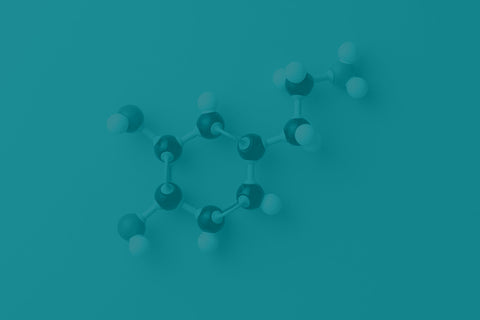
The blood-brain barrier (BBB for short) is a beautiful creation of evolution. Blood vessels that traverse the central nervous system (CNS) exhibit a series of distinct properties that tightly control the movement of ions, molecules, and cells between the vascular lumen (inside the blood vessel) and the brain/spinal cord tissue (CNS parenchyma).
Put simply, the BBB is ”stingy” and protects the brain and spinal cord from unwanted intruders, including infections, and only allows very specific compounds to pass through. This is usually a good thing, but sometimes beneficial compounds — from various pharmaceutical drugs to your favorite supplements — can’t get through either.
One such compound is gamma-aminobutyric acid (GABA), a neurotransmitter in your brain that is responsible for calming down the firing of neurons. When your neurons calm down, you calm down too. And can’t we all use just a bit (or a LOT) more calm these days?
Supplementing with GABA directly, however, is, shall we say, like throwing our money in the trash (or toilet, actually!). No matter how much you take, very little of it will pass across the BBB into the brain. This is because GABA is made in the brain itself from the decarboxylation of glutamate, an excitatory neurotransmitter. Glutamate, in contrast to GABA, is BBB permeable.
Enter N-nicotinoyl-GABA, a novel combination of niacin, a form of vitamin B3, and GABA molecularly bound together in a single compound. This combination is BBB permeable, and increases both vitamin B3 and GABA levels in the brain.
Are you ready for some brain vasodilation with a hefty side of chill? Read on to learn more about N-Nicotinoyl GABA and why we love the Russians!
N-nicotinoyl-GABA's History
N-nicotinoyl-GABA was first developed in the Soviet Union by V.M. Kopelevich, L.M. Shmuylovich, and V.I. Trubnikov in the late 1970’s.
It was developed due to the poor permeability of GABA by itself across the BBB and has been used in Russia since the 1980’s for a number of conditions, including anxiety and stress reduction.
How GABA Works
GABA is made inside the brain via the decarboxylation of glutamate, the brain’s primary excitatory neurotransmitter. This reaction requires the enzyme glutamate decarboxylase and vitamin B6.
Once GABA is made, it binds to two different receptors: GABA-A and GABA-B [1]. GABA-A controls chloride entry into the cell, and GABA-B increases potassium conductance, decreases calcium entry, and inhibits the presynaptic release of other transmitters. The end result of binding to either receptor is the decreased firing of neurons and a calming of those neural pathways.
Circulating GABA has a half-life of 5 hours [3], meaning that half will be eliminated in 5 hours and another half in 10 hours after production.
In conventional medicine, drugs that modulate GABA are used for many reasons, including:
- Surgical anesthesia (isoflurane, propofol, benzodiazepines)
- Treatment of epilepsy (gabapentin, vigabatrin, tiagabine, more)
- Alcohol withdrawal (benzodiazepines)
- Neuropathic pain (gabapentin and lyrica)
- REM sleep disorders (all of the above!)
- And more…
GABA is also found in many supplements, but as you now know, the bioavailability of oral forms of GABA is terrible!
How Niacin Works
Niacin is the generic name for nicotinic acid (pyridine-3-carboxylic acid), nicotinamide (niacinamide or pyridine-3-carboxamide), and related derivatives, such as nicotinamide riboside.
It has many roles in the body, but for our purposes here, let’s start with its role in vasodilation. Niacin is a well-known vasodilator. When given very high quantities, the infamous niacin flush dilates blood vessels in your skin making you red and feel itchy. At lower doses, it also dilates blood vessels in the brain, making the BBB more permeable in the process (go GABA go! get in there!).
In addition to being a vasodilator, niacin is turned into NAD (which is vital for energy production), it prevents neuronal apoptosis (programmed cell death), plays a significant role in neuronal development, is cardioprotective, and much more.
N-nicotinoyl-GABA's Key Benefits
When N-nicotinoyl-GABA crosses the BBB, it hydrolyzes into niacin and GABA. As a result, both molecules are active when reaching the brain.
Studies have shown that N-nicotinoyl-GABA has several key benefits, such as:
- Decrease anxiety [2]
- Improve sleep quality [6]
- Neuroprotective [7]
- Anti-inflammatory [7]
N-nicotinoyl-GABA Dosage
Effective dosage of N-nicotinoyl-GABA ranges from 30 mg to 100 mg per day. It can be ingested in a powder, tablet, capsule, and (of course!) troche form.
As with most compounds, start with a lower dose and titrate upwards until you achieve the desired effect.
N-nicotinoyl-GABA Safety
Side effects are very mild and only with high doses, however, they may include:
- Abdominal discomfort
- Headaches
- Drowsiness
Do not combine N-nicotinoyl-GABA with any other drugs or compounds that work on the GABA system. This includes drugs like gabapentin and lyrica as well as alcohol. Do not use N-nicotinoyl-GABA if you are pregnant or breastfeeding.
N-nicotinoyl-GABA in our Products
Tro Calm is our stress and tension relieving troche that contains 50 mg of N-nicotinoyl-GABA, 10 mg of CBD, 2 mg of CBG, and 100 mg of kava (30% kavalactones). All ingredients are precision dosed, physician formulated, and pharmaceutical grade.
Unwind, chill out, and decompress on-demand with Tro Calm. Calm AF never felt so good!
References
- Jewett BE, Sharma S. Physiology, GABA. [Updated 2021 Jul 26]. In: StatPearls [Internet]. Treasure Island (FL): StatPearls Publishing; 2021 Jan-. Available from: https://www.ncbi.nlm.nih.gov/books/NBK513311/
- Ngo, D. H., & Vo, T. S. (2019). An Updated Review on Pharmaceutical Properties of Gamma-Aminobutyric Acid. Molecules (Basel, Switzerland), 24(15), 2678. https://doi.org/10.3390/molecules24152678
- Li, J., Zhang, Z., Liu, X., Wang, Y., Mao, F., Mao, J., Lu, X., Jiang, D., Wan, Y., Lv, J. Y., Cao, G., Zhang, J., Zhao, N., Atkinson, M., Greiner, D. L., Prud'homme, G. J., Jiao, Z., Li, Y., & Wang, Q. (2015). Study of GABA in Healthy Volunteers: Pharmacokinetics and Pharmacodynamics. Frontiers in pharmacology, 6, 260. https://doi.org/10.3389/fphar.2015.00260
- Djadjo S, Bajaj T. Niacin. [Updated 2021 Jun 2]. In: StatPearls [Internet]. Treasure Island (FL): StatPearls Publishing; 2021 Jan-. Available from: https://www.ncbi.nlm.nih.gov/books/NBK541036/
- Hamilton, S. J., Chew, G. T., Davis, T. M., & Watts, G. F. (2010). Niacin improves small artery vasodilatory function and compliance in statin-treated type 2 diabetic patients. Diabetes & vascular disease research, 7(4), 296–299. https://doi.org/10.1177/1479164110376206
- Gottesmann C. (2002). GABA mechanisms and sleep. Neuroscience, 111(2), 231–239. https://doi.org/10.1016/s0306-4522(02)00034-9
- Ngo, D. H., & Vo, T. S. (2019). An Updated Review on Pharmaceutical Properties of Gamma-Aminobutyric Acid. Molecules (Basel, Switzerland), 24(15), 2678. https://doi.org/10.3390/molecules24152678





Comments (0)
There are no comments for this article. Be the first one to leave a message!